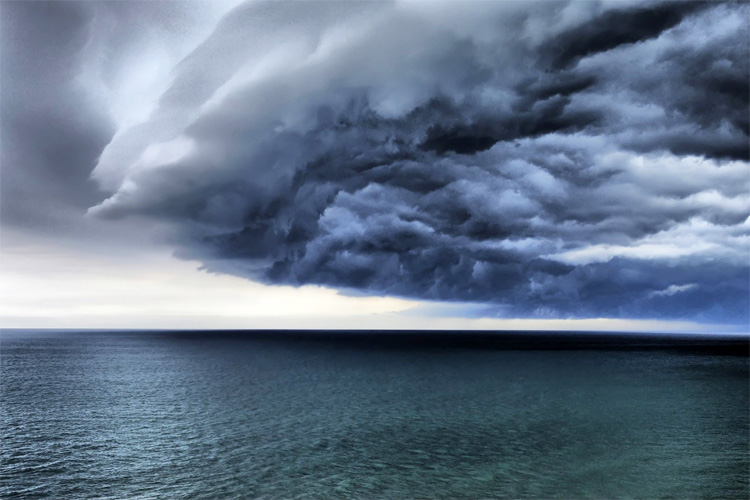Some winds have standard behaviors. Planet Earth is inhabited by several regional winds which appear and blow with pattern rules.
Air temperature, land temperature, water temperature, mountains, and geographical locations play critical roles in the behavior of the famous winds of the world.
Windsurfers, kitesurfers, and also wave-powered water sports rely on special winds to get quality surf sessions.
Consistency and power are important issues when it comes to wind and board sports.
After learning what wind is and how it is formed, it's important to know the best winds in your region for windsurfing, kitesurfing, and even riding waves.
With good anemometers, you can easily check the wind speed and air pressure.
Clouds also tell us a lot about weather patterns, while the Beaufort Wind Force Scale relates wind speed to observed conditions at sea or land.
Famous wind patterns have their working schedule, too. Some winds blow strong in the morning and fade out during the afternoon.
Other winds have special requirements and will only appear in drastic temperature changes.
So, what are the most famous winds in the world?
Abrolhos
A violent squall blowing off the southeastern coast of Brazil between May and August.
Alizé
Also known as trade wind. It Blows in the tropics predominantly from the northeast in the Northern Hemisphere and from the southeast in the Southern Hemisphere.
Bora
A gusty wind that blows in the Adriatic Sea and affects Croatia, Greece, Russia, and Turkey during wintertime.
Brickfielder
A hot and dry wind that blows in the desert of Southern Australia during the summer season.
Calima
A dust wind originating in the Sahara, which blows through the Canary Islands in winter.
Cers
A quite violent dry and clear northwest or north wind affecting the southwest of France, near the Gulf of Lion.
Chinook
A katabatic, dry, and effective wind that melts snow in the Pacific Northwest of the USA and Canada.
Diablo
A hot, dry, and offshore wind blowing in the San Francisco Bay Area during spring and fall.
Etesian
Strong, dry, north winds of the Aegean Sea that blow from about mid-May to mid-September, hitting Greece and Turkey.
Föhn
A katabatic, dry mountain wind that can raise the air temperature very quickly over the Alps into Central Europe.
Halny
A type of Föhn wind that blows in Southern Poland and Slovakia that can destroy roofs and cause avalanches.
Hamsin
A dry, hot, and dusty local wind blowing in North Africa and the Arabian Peninsula between March and May.
Harmattan
A dry and dusty West African trade wind blowing south from the Sahara into the Gulf of Guinea between November and March. It causes a haze in the sky.
Helm
A strong northeasterly wind which blows in Cumbria, England.
Levante
A warm, east-to-northeast wind that runs in the Alboran Channel and is funneled through the Strait of Gibraltar; strong Levante winds produce heavy swell.
Mistral
A strong, cold, and usually dry regional wind that affects the southeastern region of France and the entire Mediterranean Sea.
Monsoon
A seasonal reversing wind that brings precipitation to South Asia.
Pampero
A strong squall that occurs over the Pampas of Argentina and Uruguay between October and January. It brings a considerable drop in temperature, severe rain, and thunderstorms, and is followed by a cold, dry, gusty wind.
Roaring Forties
A powerful air current that blows all year round, mainly in the Southern Hemisphere, between the latitudes of 40 degrees and 50 degrees.
Santa Ana
A hot, dry easterly or northeasterly wind and blows from the pass and river valley of Santa Ana in Southern California. It is very common in Los Angeles and also known as Sundowner.
Simoom
A suffocating, strong, dry, dust-laden local wind that blows in the Sahara, Palestine, Israel, Jordan, Syria, and the deserts of the Arabian Peninsula.
Sirocco
A Mediterranean wind that comes from the Sahara and reaches hurricane speeds in North Africa and Southern Europe.
Tramontana
A cold wind from the north or northeast tinged with frigid air from the Alps and the northern Apennines, particularly to the west coast of Italy and Northern Corsica.
Vendaval
A strong, wet, and moist south-west wind associated with cyclonic activity across the Iberian Peninsula. It blows during the wet winter season, from November to April, and comes with violent squalls and thunder.
Zonda
A hot wind of the eastern slopes of the Andes in central Argentina. It starts during the afternoon, between May and November.
Explore six (un)orthodox methods for checking wind direction.
